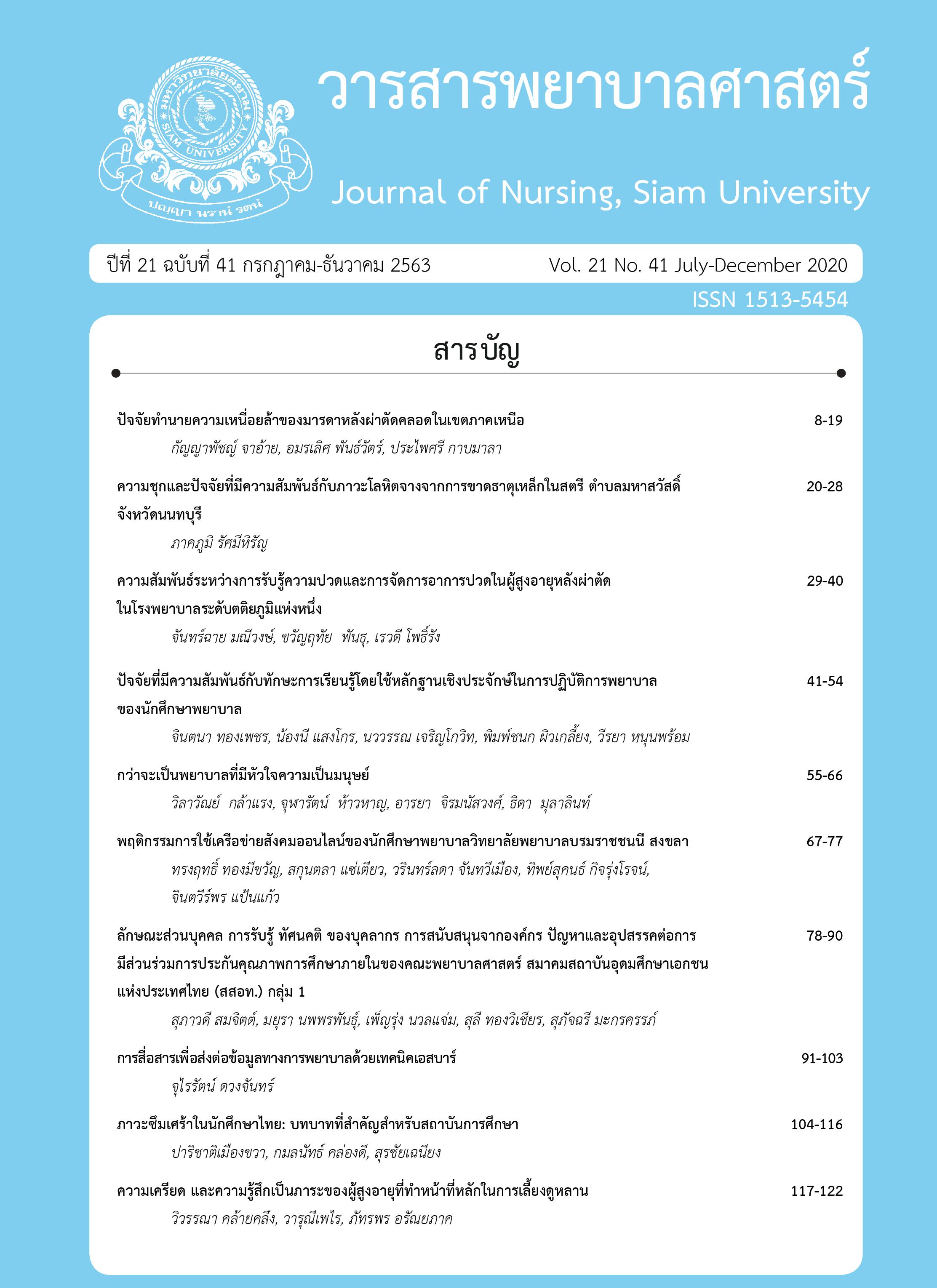The Prevalence and Associated Factors of Iron Deficiency Anemia among Female in Mahasawat subdistrict, Nonthaburi
DOI:
https://doi.org/10.14456/jnsu.v21i41.246554Keywords:
Prevalence, Iron deficiency anemiaAbstract
Iron deficiency anemia is one of the public health problem in Thailand. Anemia may be associated with increased mortality and length of hospital stay. This study aimed to investigate prevalence and associated factor to iron deficiency anemia among women in Mahasawat subdistrict, Bang-kruai district, Nonthaburi.
A cross-sectional study was conducted in 167 women(aged older than 18 years). The data were analyzed by using descriptive statistics ,Chi-square’s test, Fisher’s exact test and multiple regression for calculating the prevalence and testing the relationship between iron deficiency anemia and associated factor.
Results The prevalence of iron deficiency anemia among women was 10.78%. Those were likely to be majority in women who had the age younger than 60 years, the income more than 100,000 baht/year, education lower than bachelor’s degree, diabetes mellitus, essential hypertension, dyslipidemia, Aspirin/NSIAD usage, menstruation, working people, non-smoker, non-alcoholic drink, Marriage,and BMI between 23-29.99 kg/m2 . The related factor of iron deficiency anemia were NSAIDs/Aspirin. Empirical iron supplement without conducting a serum ferritin test can calculate number needed to treat of 2.39 and save budget 62.3-73.5 %.
Conclusion: The prevalence of iron deficiency anemia among women was 10.78%. The prevalence was lower than Thailand prevalence, Characteristics of the study population add more variability to IDA prevalence. Elevated ferritin levels may be associated with other conditions. Other laboratory tests that may be used in the diagnosis of IDA are as follows: Serum iron, Total Iron Binding Capacity (TIBC) and transferrin saturation
References
วิชัย เอกพลากร. (2557). ภาวะโลหิตจาง. ใน วิชัย เอกพลากร, การสำรวจสุขภาพประชาชนไทยโดยการตรวจร่างกาย ครั้งที่ 5 (หน้า 179-183). สถาบันวิจัยระบบสาธารณสุข.
Fonseca, C. (2017). Prevalence and prognostic impact of anemia and iron deficiency in patients hospitalized in an internal medicine ward: The PRO-IRON study. European journal haematology volume 99, 505-513.
KILLIP, S. (2007). Iron deficiency anemia. American Family Physician, 671-678.
Sinclair, L. M. (2005). Prevalence of iron deficiency with and without anemia in recreationally active men and women. Journal of the american dietetic association, 975-978.
Australasia, T. R. (2013). Iron studies standardised reporting protocol. Sydney: RCPA.
คณิตทรัพย์, น. (2553). ความชุกของโรคโลหิตจางจากการขาดธาตุเหล็กในผู้สูงอายุที่มีโลหิตจางและภาวะของธาตุเหล็กในผู้สูงอายุ. วารสารโลหิตวิทยาและเวชศาสตร์บริการโลหิต, 287-296.
กระทรวงสาธารณสุข, ส. ก. (2013.). คู่มือแนวทางการควบคุมและป้องกันโลหิตจางจากการขาดธาตุเหล็ก.
พงษ์อุดม, ศ. (2559). ความชุกและปัจจัยเสี่ยงของภาวะขาดธาตุเหล็กในบุคลากรหญิงของโรงพยาบาลอุดรธานี. วารสารโลหิตวิทยาและเวชศาสตร์บริการโลหิต, 35-41.
ไพรสนธิ์, ป. (2017, January-March). ภาวะโลหิตจางในผู้สูงอายุภาคเหนือตอนบนของประเทศไทย. Thai Journal of Nursing Council Vol.32, 133-145.
Jeong-Ok Lee, J. H. (2014). Prevalence and risk factor for iron deficiency anemia in the Korean population: Result of the fifth Korea National Health and Nutrition Examination Survey. Journal of Korean Medical science , 224-229.
Downloads
Published
How to Cite
Issue
Section
License
Content and information published in the Journal of Nursing, Siam University is the comment and responsibility of the authors.
Articles, information, images, etc. published in the Journal of Nursing. Siam University is the copyright of the Journal of Nursing, Siam University. If any person or entity wants to take all or part of it for publication for any purposes, please reference the Journal of Nursing, Siam University.



